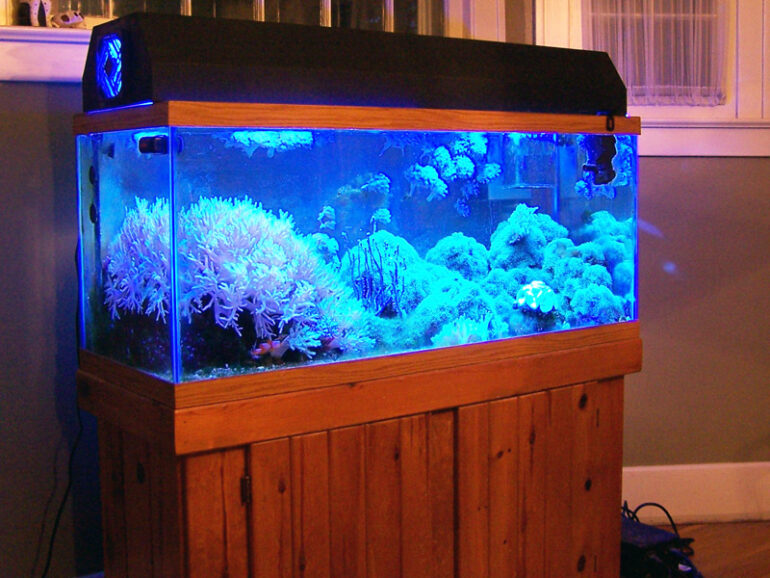When setting up a new saltwater aquarium, a lot of thought must be given to the aquatic environment inside the tank. But equally important is the environment the tank itself will occupy—its location in your home.
There are many factors that influence whether a space is appropriate for an aquarium—and once the tank is up and running, the last thing you’ll want to do is tear it down and move it because of some unforeseen problem.
Consider splashes, spills, and humidity
It’s not a question of if salt water will end up on the floor, but when. Also, water evaporating from your new saltwater aquarium is sure to drive up humidity. So you’ll need to give some thought to how moisture might adversely affect nearby furnishings, decor, artwork, hardwood floors, etc.
Keep your tank on the level
You’ll want your new saltwater aquarium to be as level as possible, so try to situate it on a relatively smooth, level, and firm surface to begin with. Then you won’t have to get carried away with shims later on!
If the floor is carpeted, consider how the thickness of the carpet and padding might affect the tank’s stability. A top-heavy tank that rocks or wobbles whenever someone walks by is a major flood—or serious injury—waiting to happen.
Can your floor bear the weight?
It’s critical to evaluate whether the floor can support the weight of an operating aquarium. You’ll need to factor in approximately 8½ pounds for each gallon of salt water plus the weight of the tank, stand, substrate, live rock, lighting and filtration equipment, etc.
Ideally, the tank should be located close to a load-bearing wall and perpendicular to as many floor joists as possible. With really big tanks, it may be necessary to reinforce or brace the floor from underneath to prevent sagging, cracking, or, in a worst-case scenario, an actual collapse. If you have any doubts, consult a structural engineer before proceeding with setup.
Are utilities close by?
Easy access to utilities is another vital issue. Are there sufficient power outlets in the room to run the lights, pumps, heaters, and other equipment? How far away is the nearest sink and drain? If they’re located on the other side of the house and up three flights of stairs, you might want to pick a new location.
What else should you consider?
- The space should provide a stable temperature. Is it chilly in the winter, hot and stuffy in the summer, or subject to dramatic temperature fluctuations from one day to the next? Is a heating or cooling source located too close by?
- Is the space flooded with natural sunlight for much of the day? That could lead to unstable water temperatures as well as algae problems down the road.
- Too much human activity in the space can stress the fish and increase the risk of accidental breakage—particularly where youngsters (and airborne toys) are concerned.
It’s about your viewing pleasure!
Last but not least, make sure your new saltwater aquarium is located in a room of the house where you can sit, relax, and enjoy it in comfort. That is, after all, why you set it up, right?




Hi all,
Trying to figure out the right place for a 180 reef tank. I found the perfect spot in the house but afraid of to much light. Can’t seem to be able to attach a photo but would like any feedback. I can send the picture through email if needed.
The room is our master bedroom and the area doesn’t get direct sunlight but there is lots of light in the room.
Thoughts?
Thank you,
Jeff
Hi Jeff! My tank is situated in a great room with a total of 16 windows in it (as you can tell from the images in this post: http://www.saltwatersmarts.com/kessil-a360w-leds-dont-disappoint-6716/), so I too have an overabundance of light streaming in. For the most part, however, the light is indirect with only occasional “direct hits” at certain times of year, so I actually have no problems stemming from the light.
You can always block or reduce the light penetration with curtains, sheers, or shades if necessary. Of course, you’ll want to be sure to keep dissolved nutrients low to prevent algae blooms, and if temperature becomes an issue, you may need to compensate for that with additional fans, an actual aquarium chiller, or some other form of cooling.
Thank you Jeff. That helps me with the placement. I am going to have an engineer look at the floor to make sure it can hold the weight.
Thanks again,
Jeff
Good thinking, Jeff. Keep us posted on your tank’s progress!
Thank you. Very good info. Too many times I have setup a tank where I had some space, but didn’t consider the fact that I couldn’t see it from any seat / chair in my house! Another thing I like to do is setup a tank within reach of a window, so I can do water changes and let the water out into the lawn. (works for water and fertilizer all in one)
Thanks for your kind comment, Brian! However, we wouldn’t recommend watering your lawn with salt water. That’s a great suggestion for freshwater systems, though.